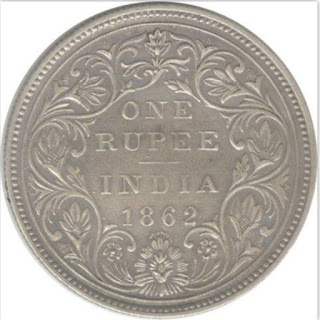By the Act of the Parliament in 1858, the Government and administration of India were transferred from the East India Company (EIC) to a council of State, under the Crown, with effect from 1st November 1858. Thus, the long rule of the EIC came to an end. This had its effect on the coinage as well. The first series of coins issued in 1862 had their obverse and reverse designs changed and the fineness of the silver coins was reduced from 917,4 to 916.6 per mille, at which standard the silver rupee remained till 1940.
Although the rupees dated 1862 belong to the first series, they may be considered a separate group because they were struck with the same date unchanged for a period of more than 12 years, until 1874. In 1874 part of the issue was currently dated but, the coins struck early in the year retained the original 1862 date and dies. These coins were struck in the three operating Government mints at Calcutta, Bombay and Madras. Dots were incorporated below the date. A 'dot' was added to the base year 1862 and would indicate 1862+1=1863, two 'dots' would mean 1862+2=1863 and so on till up to 12 dots to signify 1874. The 'Dots' indicating the year of minting, one for each year after 1862 appear below the date and above/around the top of bottom flower design.
One Dot, denotes 1863.
Four Dots, denotes 1866.
On 1862-rupee, various obverse and reverse designs have been stated by various experts. The earliest research was done by George Falcke and Robert Clarke in 1970, followed by numerous others to include D Chakravarty in 1979. The latest by Paul Stevens and Randy Weir of 2012 states six obverse and four reverse varieties. To simplify most, describe three different obverse designs and four types of reverse designs and more than 50 varieties of the 1862 one-rupee coin.
It is reported that the punches for the 1862-rupee coin, originally executed in England, were sent to Calcutta mint for preparation of 'coining dies' for use at the mint. Calcutta mint incorporated a 'dot' for Bombay mint and two dots for the Madras mint and none for the Calcutta mint.
The commonly accepted Die-variations are.
'Dots' on reverse. One dot for Bombay mint and two for Madras mint appear above 'N' of 'ONE', sometimes going even within the top flower. Calcutta struck coins have no mint marks.
Obverse A. The letters in the legend 'Victoria Queen' are close set, so 'A' of 'VICTORIA' falls short of alignment with the bottom band of the crown. Also, the front dress panel has three and three-fourth sections.
Obverse B. The letters in the legend are spaced out, so that 'A' of 'VICTORIA' is aligned with the bottom band of the crown. The dress panel has four and one-fourth sections.
Obverse C. Similar to obverse A, but the Queen's bust is shorter at the bottom and the dress panel has only three and one-third sections.
Rev.I Rev.II
Rev. II (a) Rev.III
Reverse I. The flower at the top has seven petals, those at the sides being large and curved downwards, appearing open
Reverse II. The flower has five close set petals, the top three point straight up, appears closed and blunt.
Reverse II (a). Similar to reverse II, but with pineapple like flower buds above 'O', 'N' and 'E' of 'ONE', and at top right of the second 'E' of 'RUPEE'
Reverse III. Similar to reverse I, but the petals are shorter and almost straight, pointing slightly upwards.
Coins are listed in the format A/II 1/2, which means that the obverse is of bust type A, the reverse is type II, and the dot pattern is 1 dot at the top and 2 dots at the bottom.
One Rupee 1862 A/II 0/1
One Rupee, 1862, A/II 1/2
One Rupee, 1862, B/II 0/3
One Rupee, 1862, A/1 0/4
One Rupee, 1862, A/II 0/5
One Rupee, 1862, A/II 0/7
One Rupee, 1862, A/II 0/8
One Rupee, 1862, A/II 0/10
One Rupee, 1862, A/II 0/11




























No comments:
Post a Comment
Any inputs or feedback is welcome!